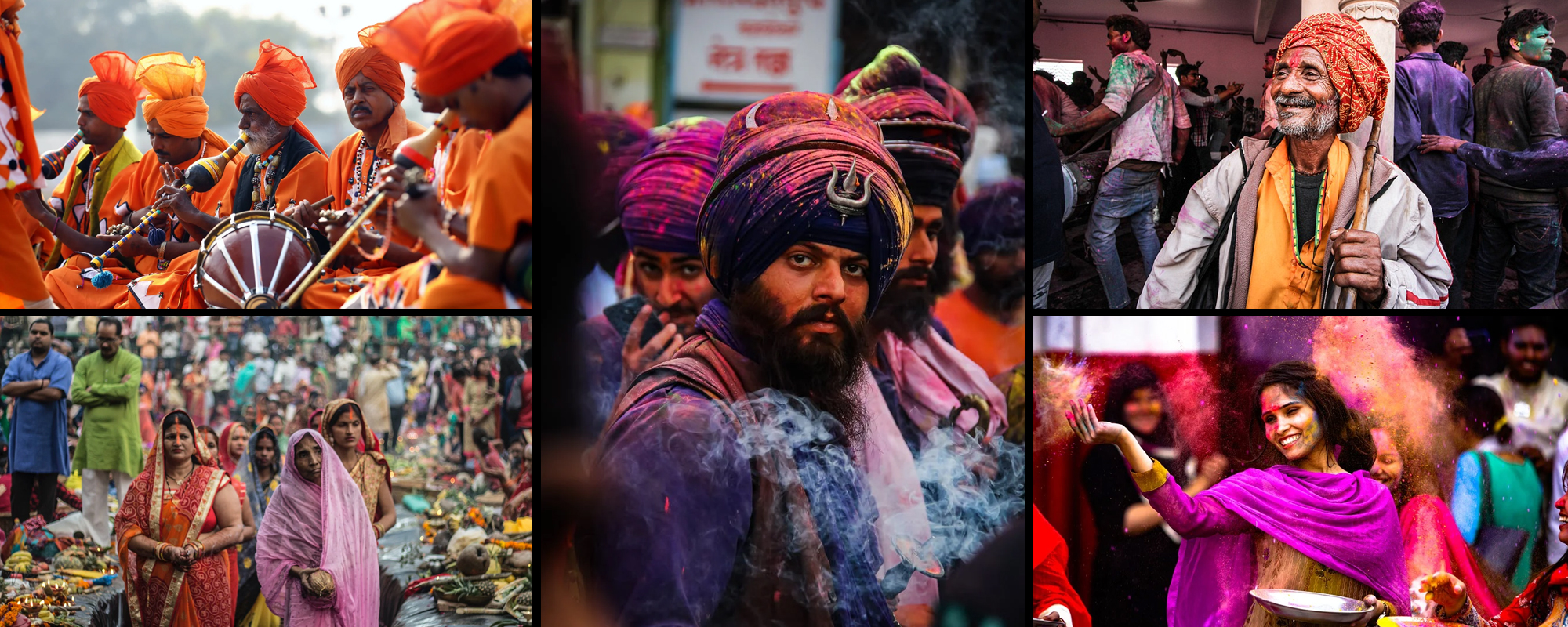
A kaleidoscopic cloud hangs over India, where revelers mark the arrival of spring by throwing powdered dye with abandon, spraying water, and flooding the streets for raucous fun. Holi may be traditionally Hindu, but everyone is equal during this holiday. This year on March 8, color will hide all class lines, the caste system will disappear, and foreigners will join the locals. Underneath the dancing and colorful chaos lies unique culture and deeply rooted tradition. Here’s what you need to know about Holi.
The most vibrant of all the festivals, the Festival of Holi is also referred to as the Festival of Colors. Holi gets its name from Holika, the demoness sister of evil King Hiranyakashyap in Hindu mythology. As the story goes, the villainous king tried to forbid his son Prahlad from worshiping one of the Hindu gods, Vishnu, but Prahlad persisted despite his father. So, the king ordered Prahlad and Holika (who was immune to fire) to sit on a pyre, a wooden structure for burning a body as part of a funeral or execution. When the flames struck, Holika burnt to death in spite of her immunity to fire, and miraculously Prahlad prevailed because he called on the help of Lord Vishnu. So, Holi celebrations serve as a reminder of the triumph of good over evil, reflecting the Hindu belief that faith and devotion leads to salvation that can be attained by everyone who believes.
Legend also holds that after being cursed with blue skin by a demon, Krishna worried that his fair-skinned consort, Radha, would no longer love him. When he complained to his mother Yashoda, she teasingly replied for Krishna to paint Radha’s face whatever color he chose, so he did. The flying multihued pigments, called gulal, remind of the story of Krishna.
Families across India lovingly prepare gujiya, a dumpling-like sweet that filled with dried fruits and nuts spiced with cardamom. Countless variations exist, but common fillings include pistachios, cashews, coconut, and raisins, which everyone enjoys during fiery Holika Dahan.
Some people toast Holi with a bhaang, a milky beverage mixed with a paste of the buds and leaves of cannabis grown high in the Himalayas. Consumed for 3,000 years, this cannabis milkshake connects through mythology to the powerful monk god Shiva–and sold in government-run bhang shops.
The festival lasts for two days and is initiated by lighting a large bonfire. This fire acts as a symbol to burn away all of the bad that occurred in the previous year and to prepare individuals and families for the opportunity of a colorful and optimistic future. Once the bonfire is lit, many people will throw in wood, twigs, or dried leaves to signify the burning of their demons.
On the following day, the day of Holi, people throw colored dye into the air for the remainder of the festival. This is what results in the famous pictures depicting the Holi Festival of colors, where participants are covered from head to toe in bright colors of various shades. As mentioned, each of the colors represents something different. Once you’ve had your fill at the festival, washing off the dye acts as the last symbolic behavior—the cleansing of past sins or evil doings.
Diwali, also known as Deepavali or the Festival of Lights, is one of the most important festivals in Indian religions. It symbolizes the spiritual "victory of light over darkness, good over evil, and knowledge over ignorance". The festival is widely associated with conflagrations between good and evil entities.
Diwali is a post-harvest festival celebrating the bounty following the arrival of the monsoon in the subcontinent. It is celebrated during the Hindu lunisolar months of Ashvin (according to the amanta tradition) and Kartika (between mid-October and mid-November). In Hinduism it generally lasts five or six days.
Diwali is connected to various religious mythical events or personalities. The day Rama returned to his kingdom in Ayodhya with his wife Sita and his brother Lakshmana after defeating the demon, Ravana. Birth of Lakshmi (goddess of prosperity). Ganesha (God of wisdom and the remover of obstacles). Other regional traditions connect the holiday to Sita and Rama, Vishnu, Krishna, Durga, Shiva, Kali, Hanuman, Kubera, Yama, Yami, Dhanvantari, or Vishvakarman.
During the festival, Hindus, Jains and Sikhs illuminate their homes, temples and workspaces with diyas (oil lamps), candles and lanterns Hindus, in particular, have a ritual oil bath at dawn on each day of the festival. Diwali is also marked with fireworks and the decoration of floors with rangoli designs, and other parts of the house with jhalars. Food is a major focus with families partaking in feasts and sharing mithai.
The festival is an annual homecoming and bonding period not only for families, but also for communities and associations, particularly those in urban areas, which will organize activities, events and gatherings. Many towns organize community parades and fairs with parades or music and dance performances in parks. Some Hindus, Jains and Sikhs will send Diwali greeting cards to family near and far during the festive season, occasionally with boxes of Indian confectionery. Another aspect of the festival is remembering the ancestors.
Copyright 2012-2024 Indiamap Digital Private Limited. All rights reserved. Privacy Policy | Terms of Use